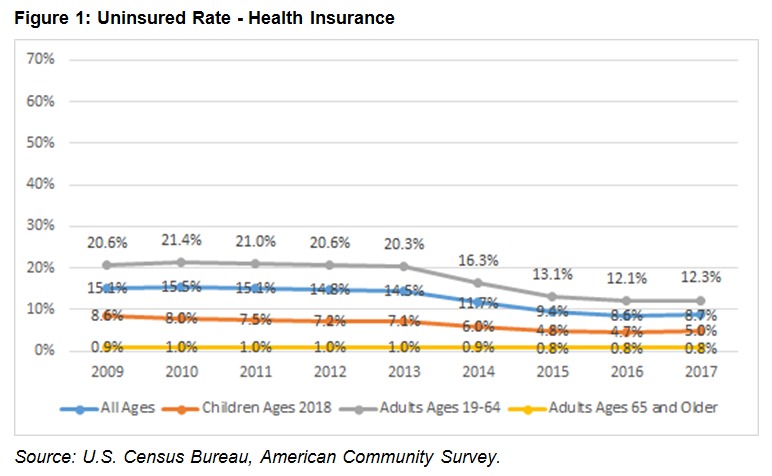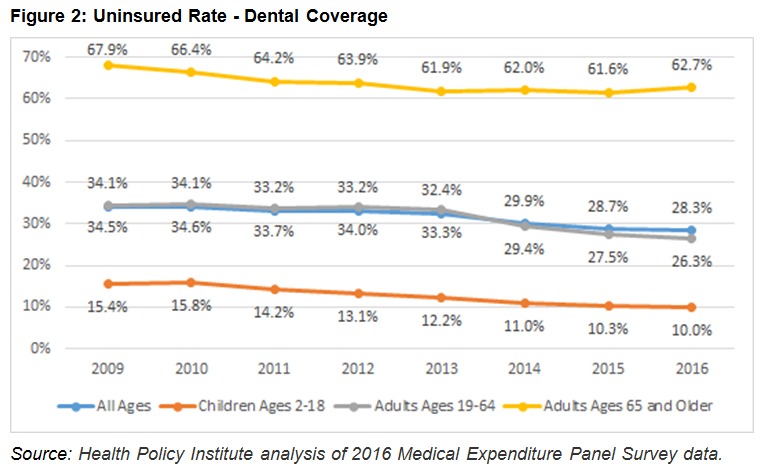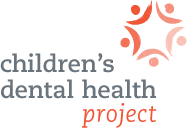The Children's Dental Health Project's blog
Progress to build on: Recent trends on dental coverage access
This blog post is coauthored by Cassandra Yarbrough, Lead Public Policy Analyst at the Health Policy Institute of the American Dental Association, and Colin Reusch, Director of Policy at the Children’s Dental Health Project. The views are the authors’ and do not necessarily represent the views of the American Dental Association.
A few weeks ago, the U.S. Census Bureau released 2017 data from the American Community Survey (ACS), including the latest health insurance statistics. For the first time since 2010 the uninsured rate in America did not fall (figure 1).
 |
While we usually refrain from labeling something as a “trend” until we have at least three consecutive data points, it definitely appears that the uninsured rate has plateaued. It is also worth remembering that these data do not reflect the impact of repealing the Affordable Care Act’s individual mandate, which did not go into effect until 2018. So next year’s ACS release will likely tell us more.
However, it is worth noting that, while the uninsured rate has stalled around 8 percent, progress made since passage of the Affordable Care Act (ACA) has been quite dramatic. In fact, the uninsured rate has been almost cut in half since 2010 when it was just over 15 percent.
Access to dental care, however, was not a main goal within the ACA. The ACA only addressed dental coverage for children, making it one of the ten essential health benefits. Therefore we might not have expected to see as dramatic a rise in Americans’ dental coverage. However, the latest data show that more people have gained dental coverage since the ACA took effect (figure 2). In fact, the proportion of Americans lacking dental coverage has declined since 2010 by about 6 percentage points.
 |
What is driving these overall gains?
- First, analysis shows that there was an increase in private dental coverage among young adults after the ACA passed, most likely due to the dependent coverage policy. Additionally, while child dental coverage was required under the ACA, the health insurance marketplaces actually sold more stand-alone dental plans to adults. Adult sales outpaced child sales almost ten to one in 2017.
- Second, the dental uninsured rate among children is at an all-time low. Thanks in large part to guaranteed oral health services for kids in Medicaid and the Children’s Health Insurance Program (CHIP), 90 percent of children now have some form of dental coverage. CHIP was reauthorized earlier this year through 2023.
- Third, 24 states that expanded Medicaid eligibility for low-income adults also expanded some form of dental coverage to newly-eligible adults.
These gains are impressive, yet there is still more to be done if we want to continue expanding access and preserve the progress made thus far. For example, health insurance marketplaces can better communicate dental plan offerings to consumers. There could also be simple prompts on web-based shopping tools like Healthcare.gov, asking them if they want to add dental coverage to their package before finalizing their purchase.
If work requirements prevent parents from enrolling in Medicaid, we could see the significant gains made in child dental coverage and utilization begin to erode as well.
And while Medicaid expansion has certainly helped put a dent in the uninsured rate, there are still challenges to resolve. In 17 states, Medicaid only covers emergency needs for adults, and in some cases nothing at all. And, one state has not extended dental coverage to their expansion adult population. Regardless of whether a state decides to expand Medicaid eligibility, offering these services to adults currently enrolled in Medicaid will help decrease the dental uninsured rate among working-age adults.
Additionally, as of October 4, 2024 eight states are pursuing the implementation of Medicaid work requirements for certain adults. These rules may create barriers to care. Children are more likely to get oral health care if their parents are utilizing health services. If work requirements prevent parents from enrolling in Medicaid, we could see the significant gains made in child dental coverage and utilization begin to erode as well.
Finally, it is important to note that these data are through 2016 and 2017 for dental and health insurance, respectively. Since 2016, several new immigration initiatives and policies have been introduced by the current administration. Studies show that since the introduction of these policies, lawfully residing immigrant families have questioned their ability to draw on public services to which they legally have access. Such fear has been further perpetuated by the recent proposed change to the public charge rule. That proposal would allow the federal government to consider use of public programs, including Medicaid, in determining someone’s legal resident status. Kaiser Family Foundation projects that the chilling effect of this policy may cause 15% to 35% of U.S. children (875,000 to 2 million) with noncitizen parents to disenroll from Medicaid. In addition to increasing the health and dental uninsured rate, this rule change could lead to immigrant families experiencing worse health outcomes, including increased prevalence of tooth decay, and increased rates of uncompensated care.
In addition to increasing the health and dental uninsured rate, this rule change could lead to immigrant families experiencing worse health outcomes, including increased prevalence of tooth decay, and increased rates of uncompensated care.
Despite the seeming plateau in the number of Americans gaining health insurance, the most recent data indicate that more children and adults are gaining dental coverage. Public programs like Medicaid and CHIP have helped drive this progress, but there has also been an increase in people purchasing voluntary dental coverage, particularly among adults shopping for health insurance in the marketplaces. While this expansion in coverage is undoubtedly related to the ACA, it isn’t completely dictated by rules like the individual mandate or the essential health benefits. This suggests, to us, that many Americans value dental coverage. They just need opportunities to find affordable coverage that allows them to get the oral health care they need. That is why it is imperative to not only continue supporting access to private dental plans, but to also protect and expand dental coverage through public programs.
